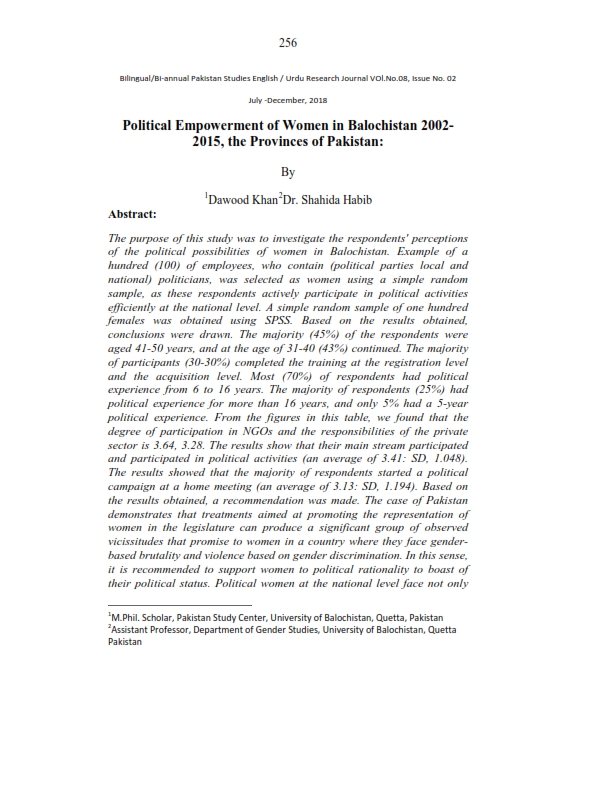Artical Political Empowerment of Women in Balochistan 2002- 2015, the Provinces of Pakistan
Keywords:
: political empowerment, women, Balochistan, PakistanAbstract
The purpose of this study was to investigate the respondents' perceptions
of the political possibilities of women in Balochistan. Example of a
hundred (100) of employees, who contain (political parties local and
national) politicians, was selected as women using a simple random
sample, as these respondents actively participate in political activities
efficiently at the national level. A simple random sample of one hundred
females was obtained using SPSS. Based on the results obtained,
conclusions were drawn. The majority (45%) of the respondents were
aged 41-50 years, and at the age of 31-40 (43%) continued. The majority
of participants (30-30%) completed the training at the registration level
and the acquisition level. Most (70%) of respondents had political
experience from 6 to 16 years. The majority of respondents (25%) had
political experience for more than 16 years, and only 5% had a 5-year
political experience. From the figures in this table, we found that the
degree of participation in NGOs and the responsibilities of the private
sector is 3.64, 3.28. The results show that their main stream participated
and participated in political activities (an average of 3.41: SD, 1.048).
The results showed that the majority of respondents started a political
campaign at a home meeting (an average of 3.13: SD, 1.194). Based on
the results obtained, a recommendation was made. The case of Pakistan
demonstrates that treatments aimed at promoting the representation of
women in the legislature can produce a significant group of observed
vicissitudes that promise to women in a country where they face genderbased brutality and violence based on gender discrimination. In this sense,
it is recommended to support women to political rationality to boast of
their political status. Political women at the national level face not only
political, but also economic, social and other constraints. In this sense, it
is recommended to ensure the participation of women in all spheres of life
in order to endorse the political spirit of women as a vibrant feature.
References
Ellis, F. (2000)Rural Livelihoods and Diversity in Developing
CountriesOxford: Oxford University Press
Gilbert, N. (2001), “Researching social life”, 2ndedn, Sage, London.
Haroon, A. (2010). Gender Review of Political Framework for Women
Political Participation: Anis TA 4602-PAK: Institutional
Strengthening of NCSW–Support for Implementation of GRAPs.
National Commission on the Status of Women Pp 1-36.
Hussein, K, and John, N. (1999)Sustainable Livelihoods and
Diversification, IDS Working Paper 69. London: Institute of
Development Studies.
Hussey, J. and Hussey, R. (1997), “Business research: A practical guide
for undergraduate and postgraduate students”, Palgrave, New
York.
Krejcie, R. V. & Morgan, D. W. (1970). Determining sample size for
research activities: Educational and Psychological Measurement.
Sage Publication, Inc. Vol. 30, p. 608.



